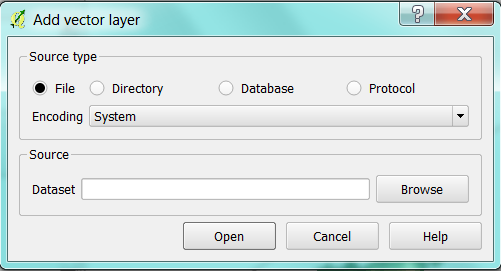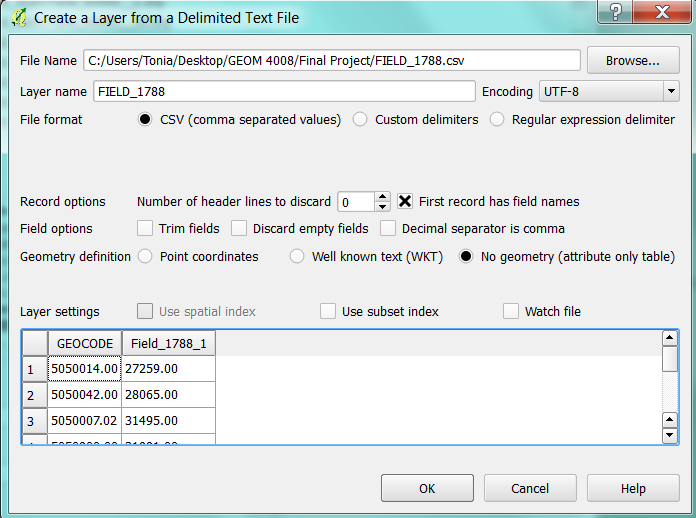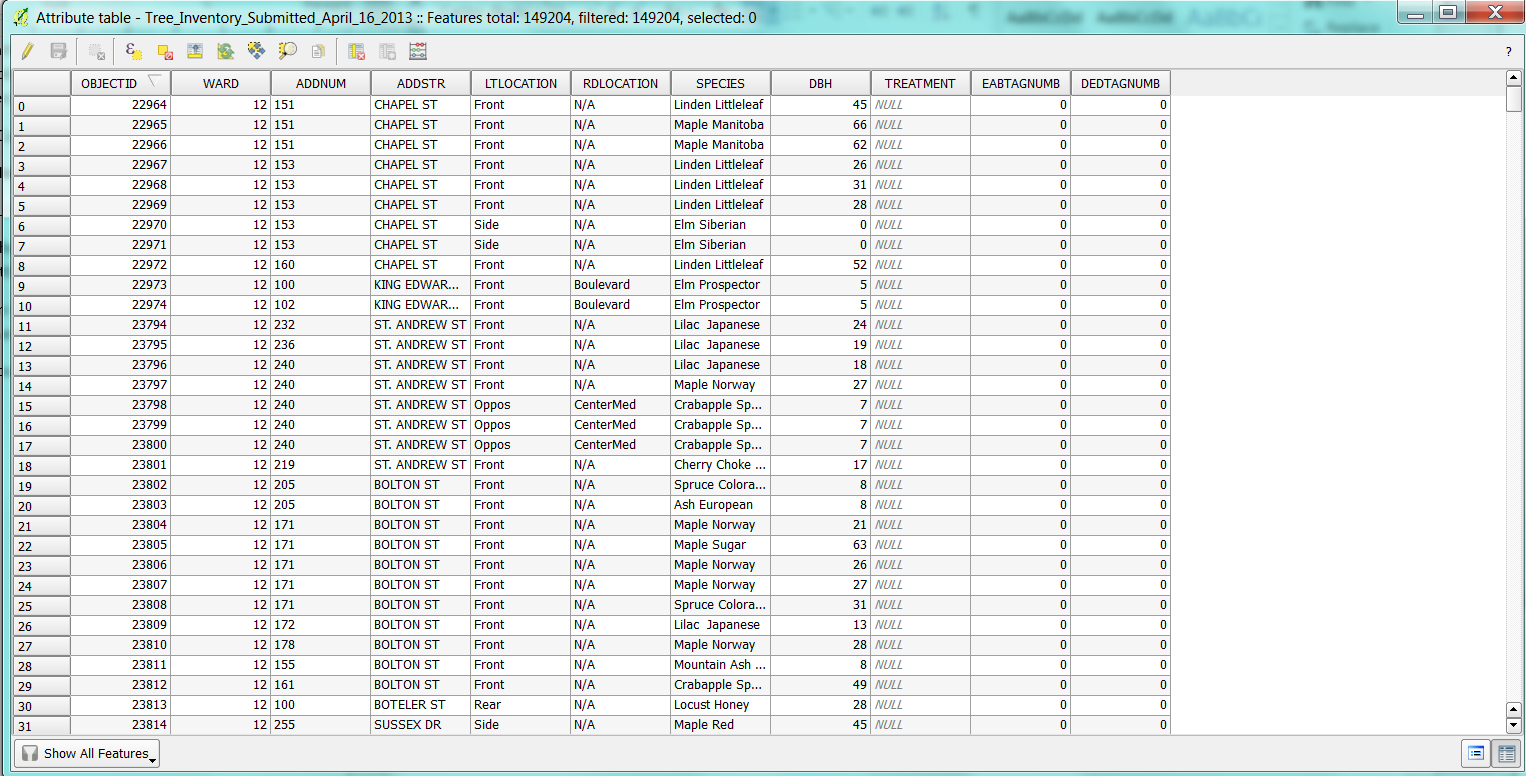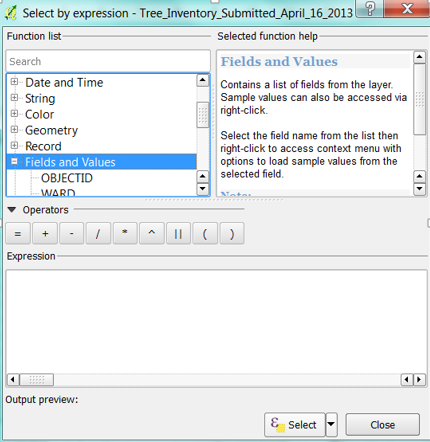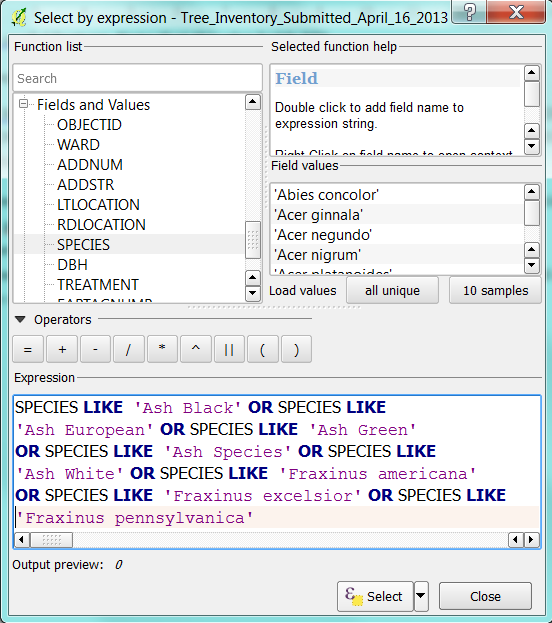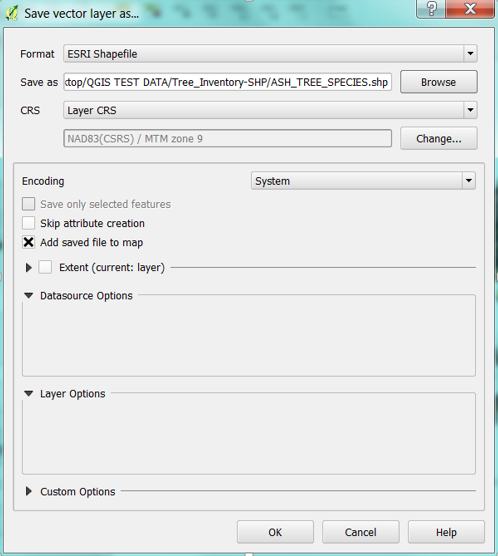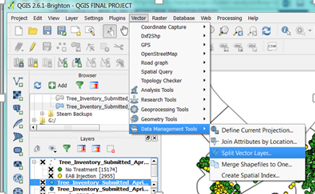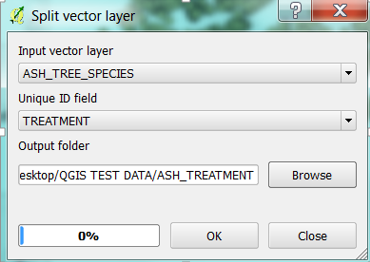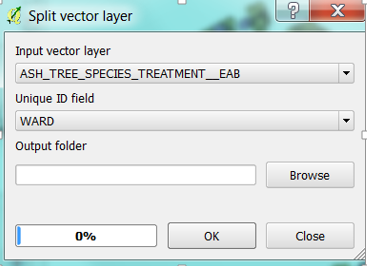Hierarchical Cluster Analysis using QGIS and R
Contents
Purpose
The purpose of this tutorial is to familiarize users with open source software, that will teach them how to manipulate, process, and map using freely accessible data. This tutorial will teach users skills such as:
- adding shp and csv data
- preforming complex attribute queries
- creating new layers from selected features
- Splitting vector layers
- Creating joins
- Adjusting layer visual features
- Creating raster heatmaps
- Generating a distance matrix
- Conducting a hierarchical cluster analysis
Installation
Quantum GIS (QGIS)
QGIS is a free and open source GIS software that is available for download from the QGIS website and compatible with all systems. It is a member of the GNU project and provides access to spatial data processing, manipulation, and visualization. Its interface is similar to ArcMap, but has fewer tools. Similar to R, users are able to create new tools for QGIS by programing python scripts that must be approved by the QGIS team. Once approved the scripts become downloadable plugins for the program.
Download and Install QGIS
- Click on the following link to download the QGIS software [1]
- The version used in this tutorial was version 2.6.1
- Click on the download option and select the option that is appropriate to your operating system.
- The program should begin to download, once it is finished downloading, run the program and follow the prompts.
The R Project
R is a freeware package used for statistical computation and graphic generation within a coding language environment (Torfs & Brauer, 2014). It was an original member of the GNU project, as it provides free software for all operating systems available for download from the r-project website. R is often used both in educational and professional contexts (). What makes this system invaluable is its flexibility, in that there are often many ways to preform simple tasks and its capabilities are constantly growing as users code new functions in downloadable packages that can be added to the main system.
Download and Install R
- Click on the following link to download R [2]
- Choose the appropriate system to download the program
- Once downloaded run the file and follow the prompts
Required Data
Shapefile Data
The data is freely available and downloadable by accessing the following websites. Once on the website selecting the appropriate files for download, save them to the computer in an appropriate file and unzip them. The following is the list of data required to compete this tutorial.
- City of Ottawa street tree inventory shapefile (Tree_Inventory_Apr 2013 shp) [3]
This layer contains point data as a shapefile of all City of Ottawa City-owned trees, which includes street trees and some park trees. It is a tree inventory database that was developed by City of Ottawa forestry staff in the field using GPS software. The data was published by the City on April 22, but the dates when it was collected are unknown. It contains data such as locational information for trees, their species type and treatment regimen.
- City of Ottawa Ward boundaries 2010 shapefile(wards-2010-2 shp) [4]
This is a shapefile of polygon data for the City of Ottawa’s 23 wards, that was published by the city.
- Canadian Census Tract boundaries 2006 [5]
The census tract boundary is one of the smallest, and most static political boundaries. This file contains polygon census tract boundaries for major metropolitan areas in Ontario.
csv data
- Canadian Census 2006 Income and Earnings – this file is available from Carleton University or by downloading it from this page File:FIELD 1788.pptx
This file contains the data from field 1788 of the Income and Earnings portion of the 2006 Canadian Census for all Ottawa census tracts. Field 1788 is the median family income after taxes.
Adding files to QGIS
Loading shapefiles To load the shapefiles into QGIS either find the files in the Browser and double click the file(s) or use the Add vector layer tool located on the sidebar of the program window.
If you are using the Add vector layer tool (![]() ), select the tool, use the Browse button in the source section to locate the files and then select Open. Repeat this step to load each shapefile.
), select the tool, use the Browse button in the source section to locate the files and then select Open. Repeat this step to load each shapefile.
Note: All of the files are from the City of Ottawa and as such they all are projected in MTM zone 9 NAD83, as their projections are all the same and recognized by QGIS there is no need to set or change their projection.
Loading the csv data
Once the census data file is downloaded from this webpage, open it and copy all the contents of the table. Open the program excel or another spreadsheet program, paste the data into the spreadsheet using match destination formatting and then save the file as a csv. Open the program Notepad, type "String","Integer" and save the file as a csvt using the exact same name as the csv file. This is an important step because it prevents QGIS from discarding the zeros that follow the decimal place in the census tract geocodes when it is uploaded.
To load the table into QGIS in the main menu select Layer, then select Add Layer from the drop down menu and then select Add Delimited Text Layer.
The Create a layer from a delimited text file window will open. In the new window select the Field_1788 csv file. All other selections should look like the following. Once complete, select OK.
You will notice that the file is now table in your layers list.
==
Manipulating and displaying data in QGIS
A Multi-Criteria SQL Feature Selection
The purpose of this part of the tutorial is to identify all true ash tree species data points from the City of Ottawa tree inventory vector layer. The features selection tool is used to select features from an attribute table using SLQ (Structured Language Queries)
- In the layers window, right click the “Tree_Inventory_Apr 2013” vector layer, then from the drop down menu select Open Attribute Table. Your attribute table should look something like this.
- To perform the query click the Select Features using an Expression button(
 ) in the layer attribute table window.
) in the layer attribute table window. - Expand the fields and values in the function list, notice that there is a list of the different attribute fields from your data set.
- Scroll down the function list and select the species field. Once it is selected, under the field values select the Load values all unique.
Note. This dataset uses a combination of naming methodologies, it uses Latin species names the species’ common name under the species attribute field, therefore both name types must be selected in the query.
Write in the query expression
The purpose of this query is to select all true ash species from the dataset using SQL in the select by expression tool. The following is a query expression that selects ash species from the dataset using both their common name and Latin species name from the Species field. The expression can be generated by double clicking names in the field values column and injecting the required SQL such as “LIKE” and “OR”, which can be found by expanding the Operators Group in the Function list. The operators are then added to the expression by double clicking on them or by typing them in manually. The LIKE operator is used before a field value meaning that it will select field values that are similar to but not necessarily equal to the field value that is selected. The OR operator links components of the expression together and indicates that not all of the conditions of the expression must be met to produce a selection.
This particular expression is more complex in that it is composed of eight conditions for data selection. The query expression should look like the following.
- Once the query has been entered choose the select button and close the window. Notice that in the attribute table window the number of selected features is shown. From the selection query there should be 18,129 features selected.
- To see the selected features choose use the move selection to the top button (
 ), to see the species in alphabetical order you can click on the species column.
), to see the species in alphabetical order you can click on the species column.
Now we want to get rid of all non-ash species data from this layer.
- Click the toggle editing mode button(
 ) to turn on the editing function.
) to turn on the editing function. - Choose the invert selection button (File:B3.png)) to invert the selection so that all non-ash species are selected. The table should look similar to the one bellow.
- Choose the delete selected features button (
 ).
). - Turn off the editing function by clicking the toggle editing mode button (
 )
)
I have achieved mixed results with previously discussed methodology, as attempting to delete selected features has occasionally caused QGIS to crash. Below is an alternative method for achieving a similar result by creating a new layer from the selected features rather than by deleting un-desirable features.
- If the non-ash species are selected in the attribute table invert the selection using the invert selection button (File:B3.png)). Now all ash species should be selected.
Create a new Vector Layer
- Minimize the attribute table. In the main menu open the Edit menu and select the copy features option.
- Reopen the Edit drop down menu and select the Paste Features as and from extended menu select New Vector Layer.
- A new window will open, the Coordinate Reference System Selector. As the vector already has a coordinate reference system associated with it select OK.
- A new window will open, "Save vector layer as...", where you have to choose where you will save the file by selecting browse, and will name your new vector shape file.
- Select OK. Your new layer should appear on your map and in your layers list.
Splitting Vector Layers
In the later sections we will need to analyze ash tree data based on whether or not they have been injected against EAB (emerald ash borer) infestation or not. If you open up the attribute table for the ASH_TREE_SPECIES layer, you will notice that there is a field called TREATMENT. This field indicates whether each ash tree has been injected against EAB, trees that have been injected against EAB will contain the value EAB in the TREATMENT column, whereas trees that have not been injected will contain the value NULL.
To split up the data between EAB and NULL treatments we could use a methodology similar to the previous section, by selecting features and creating a new layer. However, a quicker alternative is to use the Split Vector Layer tool. The Split Vector Layer tool splits up vectors by selected fields and creates new vectors based on groups of field values. It is useful for splitting up fields that have many field values, but is generally used to split fields that have discrete categorical data.
- To access the Split Vector Layer tool in the main menu select Vector, from the drop down menu select Data Management Tools, and then Split Vector Layer.
- A window will open for the Split vector layer tool. Select the ASH_TREE_SPECIES layer as the input vector layer and TREATMENT as the unique field ID. Select the output folder where you want the files to be saved or create a new folder by clicking Browse. Once a folder has been selected click OK.
- The program will alert you when the task is complete. However, the two new layers will not automatically load into your map so you must either add them using the add vector layer tool or select them from the appropriate folder in the browser section of the main menu. If you need a refresher as to how to do this refer back to the add shapefile section of this tutorial.
- Once added, you will find that they have been automatically named either ASH_TREE_SPECIES_TREATMENT_EAB or ASH_TREE_SPECIES_TREATMENT_NULL.
Splitting the ASH_TREE_SPECIES TREAMENT_EAB vector layer further
In this section we want to split the ASH_TREE_SPECIES_TREATMENT_EAB vector layer further, by splitting the data by city ward. To achieve this, repeat the methods used previously in this section which used the Split Vector Layer tool.
- Once the tool is open select the ASH_TREE_SPECIES_TREATMENT_EAB layer as the target layer and the WARD field as the Unique ID field.
- -The result of the split should be 23 vector layers of data for Ash trees injected against EAB by ward. Again, add the desired layers to the map using the steps outlined in the add shape file layer data section of the tutorial.
Selecting Data using the Select by Location Tool
The Canadian census boundaries layer includes polygons that are not in Ottawa. Therefore, in this section we will eliminate all polygons from the data set that are not located in Ottawa. To do this we will use the Select by location tool.
- Select the Select by location tool by opening the Vector menu, from the drop down menu select Research Tools, and then select Select by location.
- A window for the tool will open, select the census boundaries layer as the first file and the wards layer as the intersect. The window should look similar to the following image. Once complete, select OK.



